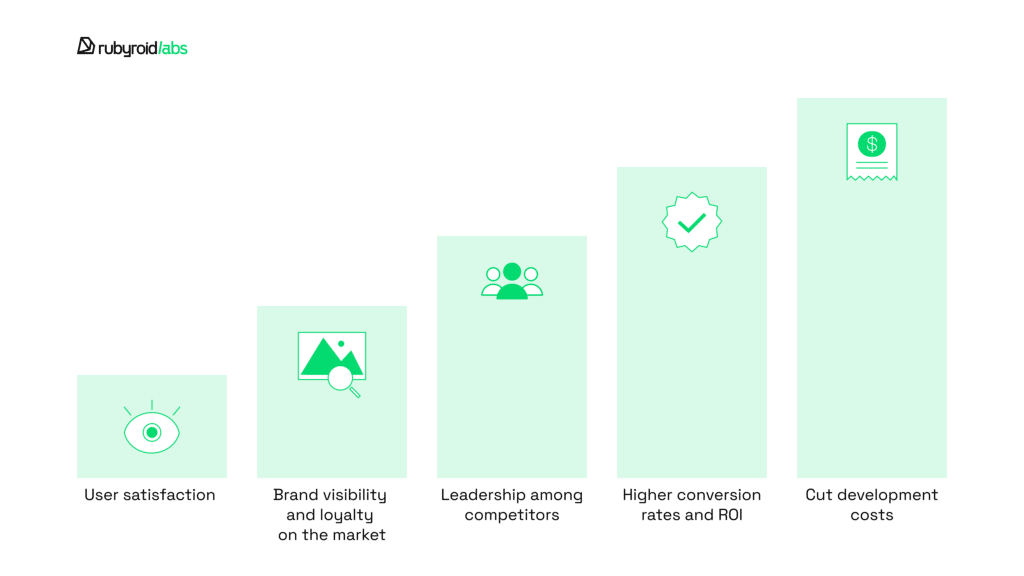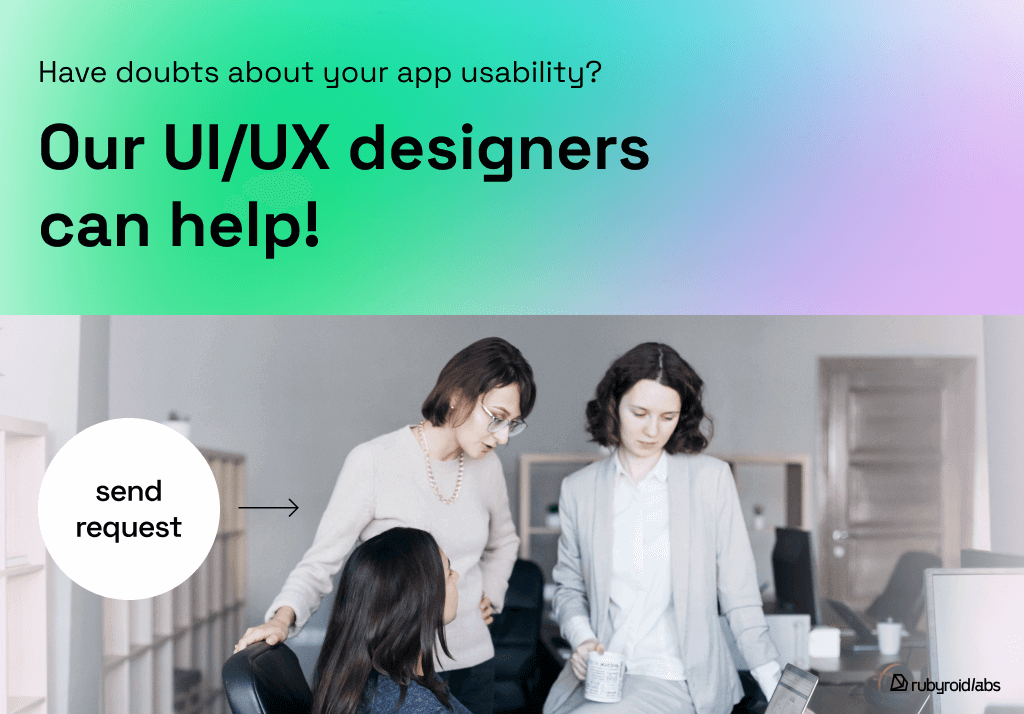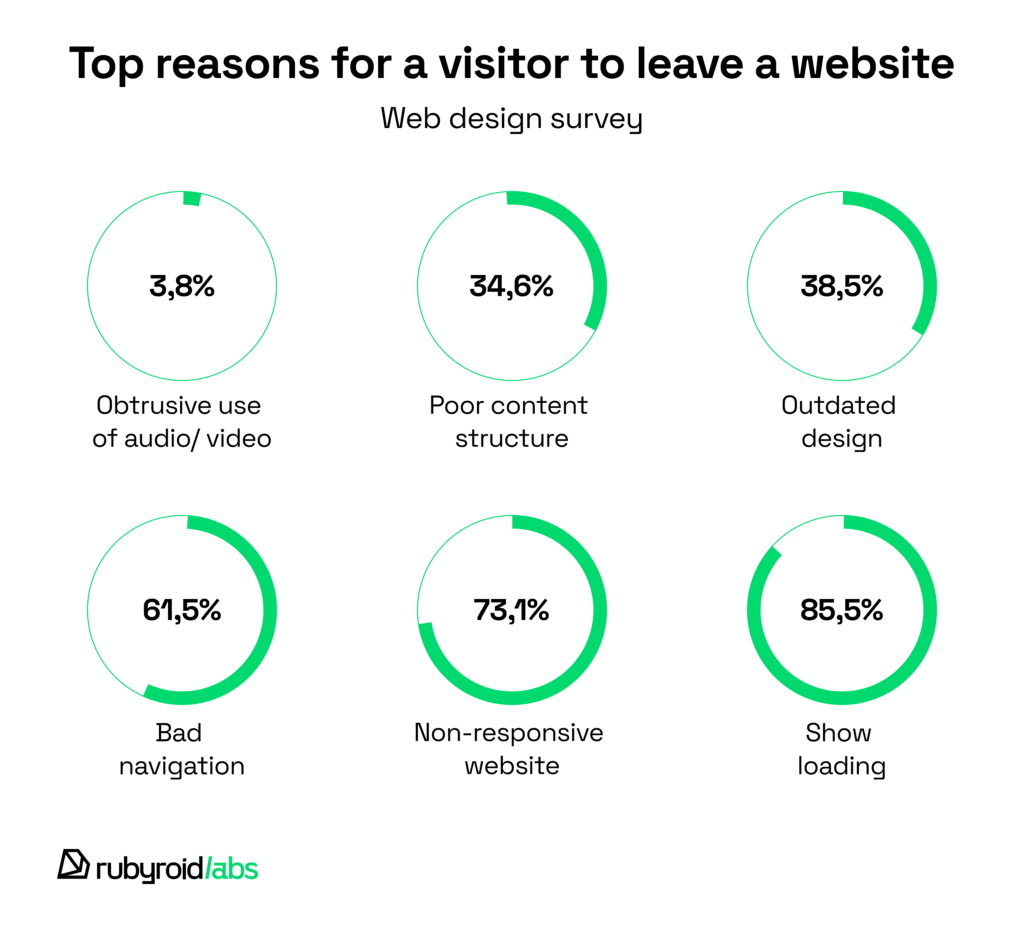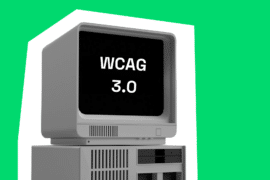Imagine you have an innovative idea for a digital project and plan to implement the latest cutting-edge technologies to disrupt the market and outperform all competitors. That’s an exciting goal!
However, there’s a catch. Without great user experience (UX) design, even the most revolutionary project might fail to impress end users. A complex, disorganized, and poorly designed product won’t succeed in the market.
A good UX design is crucial for projects of any complexity and industry. It enables your product to stand out by organizing all the data in a manner that enhances user interaction, encouraging them to return to it and recommend it to others.
This is precisely what UX designers at Rubyroid Labs do when working on a project. They identify users’ pain points, dive into the problem, and create an intuitive interface through research, usability testing, user testing, and design thinking.
With 11 years of design experience, including work for clients like Volvo, Sail Croatia, and Full Kitchen, our specialists perform UI/UX design audits to ensure interfaces meet both business objectives and the needs of the target audience.
In this post, we’ll focus on why UX design is important and highlight its critical role in any project through five key arguments and benefits.
Contents
- 1. User satisfaction
- 2. Brand visibility and loyalty on the market
- 3. Leadership among competitors
- 4. Higher conversion rates and ROI
- 5. Cut development costs
- What happens when companies fail to invest in UX design?
- What are other benefits of UX design?
- Summing up
Starting our journey, let’s recall that UX design is not about only the visual appearance of a website. Icons, buttons, animations, colors, typography, and other details are part of the UI design, which is closely tied to the UX design.
User experience design is about planning human-computer interaction step by step, considering the user’s needs, to make the audience enjoy utilizing the product. Meanwhile, user interface design provides a visual concept of what all those steps will look like.
The goal of a professional UX designer is to create user-centric products, involving the following aspects:
- Identifying specific user problems and conducting user research;
- Defining user journeys and user personas to understand who will interact with digital product and how;
- Developing the information architecture of the product and interaction design, organizing content to make it easy to navigate;
- Creating wireframes and prototypes to visualize the layout and interaction patterns before moving them to detailed design and development;
- Ensuring the product is accessible to all users, including those with disabilities;
- Working closely with cross-functional teams, including product managers, developers, content strategists, and stakeholders, to ensure the design meets both potential users needs and business goals;
- Assisting the development team in implementing the design and modifying it according to feedback from stakeholders and the target audience.
UX design matters as its meaning is much deeper than just a pretty interface, and prioritizing it can only yield positive outcomes for your product and business.
Let’s look closely at the five key arguments for the importance of user experience design.

1. User Satisfaction
According to a Salesforce study, 72% of consumers will tell 6 other people about their positive digital experiences. Let’s study how it works.
The way a product is designed directly influences how end users feel about it, whether they find it frustrating and difficult or intuitive and silky. When an app is easy to understand, its information is well-thought out, and the product meets the user’s needs, the audience can easily reach their goals with little effort and get a seamless experience.
This positive effect provides a good user experience and leads to an increased audience’s satisfaction level, which is essential for encouraging repeat use and long-term involvement. Satisfied consumers are more likely to become product champions, spread the word about their pleasant experiences, and attract new users.
2. Brand Visibility and Loyalty on the Market
UX design can influence brand recognition and develop consumer loyalty.
A unique, simple, and user-friendly design may help a business stand out in a competitive marketplace, making its products or services easily identifiable and chosen by people.
This creates a strong brand identity, attracting new consumers and retaining existing ones. Thanks to a well-structured UX design, users associate the brand with positive experiences and ease of use.
Furthermore, a company that regularly delivers a flawless user experience gains its consumers’ loyalty, which builds a positive brand reputation.
Happy clients turn into brand ambassadors, recommending products and services to others, thereby organically expanding the company’s reach. Therefore, their emotional connection to the brand can transform casual users into devoted consumers and long-term brand advocates.
3. Leadership Among Competitors
Investing in the product’s UX design can move your company to the top of the market, leaving competitors behind.
When an app is focused on providing people with amazing user experiences and resolving their demands, it brings the company to leadership. As a leader, a company can shape market trends and establish new quality standards and innovations.
This result attracts more talent and investments and can make a company more attractive to top specialists and forward-thinking investors.
By choosing UX/UI designers from Rubyroid Labs, you gain dedicated professionals who feel free in whatever industry, including ecommerce, automotive, media, fintech, lifestyle, travel, or insurance. We can design your app from scratch or provide UI/UX audit of your existing one to identify why your users might be dropping off and then improve the navigation to make it more engaging, clear and user-focused.
4. Higher Conversion Rates and ROI
Investing in UX design is a strategic business choice that has a direct influence on conversion rates and return on investment (ROI).
A streamlined and engaging user experience is essential for moving potential consumers through the conversion funnel, from initial interest to ultimate purchase or action. UX design raises conversion rates dramatically by reducing friction and improving happiness at every touchpoint.
Successful UX outcomes, such as increased user happiness and brand loyalty, lead to a greater return on investment (ROI), making UX design a critical investment in a product’s success.
5. Cut Development Costs
When you integrate UX design principles early in the development process, you can identify and solve user needs and problems before they become costly to fix. With this approach, you can avoid developing features or products that don’t meet user expectations.
A well-designed UX can streamline the development process itself. With clear and detailed design specifications, developers can work more efficiently, reducing the time and resources needed. This collaboration between UX designers and developers accelerates the development cycle and enhances the quality of the final product.
By investing in UX design, you can also cut support costs by minimizing the user issues that require assistance. A user-friendly product is intuitive and easy to navigate, which decreases the number of support calls and inquiries. This not only saves on support costs but also improves overall customer satisfaction, as users are able to solve problems independently.

What Happens When a Business Ignores Investing in UX Design?
As we can see from each of the five elements above, a well-executed UX design helps businesses thrive. However, not every company recognizes these benefits, neglecting this phase at the outset of the development process.
On this scale, it’s critical to realize that skipping investing in UX design is like setting sail without a map. You will keep going on your adventure and make progress, but the chances of getting lost or meeting unexpected barriers will grow dramatically.
Ignoring UX design may result in a number of undesirable effects that can lead to long-term consequences for the brand’s reputation and financial stability:
- User Frustration: When users meet a product that’s hard to use, their irritation leads to a negative first impression, viewing it as user-unfriendly, confusing, and inefficient. A customer who gets lost within a website’s user flow or struggles to make a purchase will hardly give the product another chance. As a result, the company risks losing potential customers and loyal clients.
- Higher User Dropout: Today’s users are impatient with learning curves; they want products that make their lives simpler right away. An unintuitive product discourages continued usage, resulting in a higher rate of user abandonment. This tendency reduces user engagement, blocks long-term user base growth, and threatens the product’s commercial viability.
See below the top reasons why people abandon websites, according to Goodfirms 2023 research.

- Increased Support Costs: Products that are difficult to navigate and use demand more customer service, which raises operating expenses. Support staff are overloaded with inquiries that might have been avoided with better design, spending resources that could have been invested in promotion or other product development.
- Damaged Brand Reputation: Negative experiences can quickly lead to negative feedback and word-of-mouth, harming the brand’s reputation. In today’s world, the internet and social media have a strong influence on a brand’s market position. As such, a damaged brand image may spread rapidly, making it challenging to attract new users and retain existing ones. Moreover, the production of future products under the same brand could also be jeopardized.
- Lower Profits: A poorly designed and complex product is less used. This fact lowers the business’s income and its return on investment (ROI). So, to fix the situation, the project will need extra expenses for redesign and rebuilding to upgrade the product and decrease user complaints.
Of course, UX design is not the only factor in a product’s success. The project idea, the technology, the quality of the development team, marketing strategy, and promotion—all these elements play on the same team.
What are Other Benefits of UX Design?
Beyond the core arguments already discussed, UX design offers more benefits that can have a profound impact on both users and businesses.
Enhanced Accessibility
UX design facilitates the creation of inclusive apps that are accessible to a wider audience. This enables a business to grow its user base and promote equality, making it more socially acceptable.
Improved User Retention
A positive user experience motivates users to spend more time on your website or app and return more frequently. UX design helps to reduce customer discomfort and friction, lowering rates of abandonment and increasing retention.
Enhanced Product Scalability
A good UX basis facilitates future product scalability. Establishing clear design patterns and standards allows a company to ensure stability when it adds new features or extends its services, maintaining a cohesive user experience across their product ecosystem.
Reduced Support Costs
A well-designed web application minimizes the frequency of user mistakes and the need for extensive customer support. A business may reduce support expenses and increase user happiness by eliminating possible troubles through scrupulous UX design.
Summing Up
According to Forrester Research, investing in the UX design process can bring a significant return on investment, with some companies reporting an ROI of up to 100x or more in certain cases.
This means that having a high-quality UX design has a long-term profit. The benefits it delivers might last for months or even years, increasing your loyal client base, elevating your company’s reputation, and generating higher income.
If you’re looking to develop a web or mobile app from scratch, need to assess whether your existing product is still relevant in the market or requires a redesign, reach out to us.
Rubyroid Labs ranks among the top 3 Ruby on Rails companies on Clutch.co. Our UX and UI designers have over 5 years of experience in web and mobile visual design and user experience expertise.
Send us your request, and our designers will discuss all your ideas with you.




